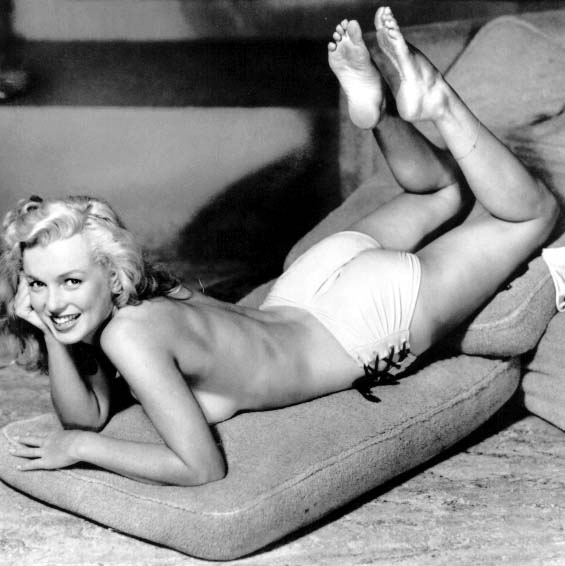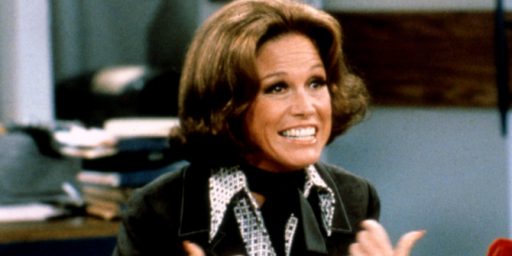Marilyn Monroe Was NOT a Size 12!
It's often said that 1950s sex symbol Marilyn Monroe was a size 12. It just isn't so.
It’s often said that 1950s sex symbol Marilyn Monroe was a size 12. It just isn’t so.
Virginia Postrel, Bloomberg (“Hollywood Auction Ends Myth of Zaftig Marilyn“):
We should never again hear anyone declare that Marilyn Monroe was a size 12, a size 14 or any other stand-in for full-figured, zaftig or plump. Fifteen thousand people have now seen dramatic evidence to the contrary. Monroe was, in fact, teeny-tiny.
[…]
In fact, the average waist measurement of the four Monroe dresses was a mere 22 inches, according to Lisa Urban, the Hollywood consultant who dressed the mannequins and took measurements for me. Even Monroe’s bust was a modest 34 inches.
That’s not an anecdote. That’s data.
The other actresses’ costumes provided further context. “It’s like half a person,” marveled a visitor at the sight of Claudette Colbert’s gold-lame “Cleopatra” gown (waist 18 inches). “That waist is the size of my thigh,” said a tall, slim man, looking at Carole Lombard’s dress from “No Man of Her Own” (a slight exaggeration — it was 21 inches). Approaching Katharine Hepburn’s “Mary of Scotland” costumes, a plump woman declared with a mixture of envy and disgust, “Another skinny one.”
The pattern she noticed was real. At my request, Urban took waist measurements on garments worn by 16 different stars, from Mary Pickford in 1929 (20 inches) to Barbra Streisand in 1969 (24 inches). The thickest waist she found was Mae West’s 26 inches in “Myra Breckinridge,” when the actress was 77 years old.
Waist sizes are easy for the general public to notice and understand. Trained eyes find other patterns that can only emerge when costumes are examined together, rather than treated as individual icons based on who wore them.
While this is fascinating and does indeed provide hard data to combat a myth that’s somehow persisted for years, it’s not like we don’t know what Monroe looked like. She was, after all, in quite a number of movies and was probably the most photographed women of her day. Her iconic figure is thus well documented and preserved for posterity. How anyone could look at those images and conclude that she was soft, much less chubby, is beyond me.
via Glenn Reynolds







Anything is possible with delusion.
This is a situation that needs some perspective.
I weigh 118 pounds now. When I was a teenager I ran about 112-116. I sewed some for myself, and for my dimensions when I was, say 14-16, a pattern in size ten fit. That was, say, 1970 or thereabouts. Sizewise in the stores, I run a 6 to 8 now, depending on how much the stores want to kow-tow to a larger clientele.
If French designers say she wore a 12, that was probably true at the time — what ,1950?
But that has no pertinence to a 22-inch waist.
How tall was she?
We have a 35-year-old darlin’ running through our household who wears a current 0 or 2, depending upon how much she ate last month. But she’s about 5’2″.
Marilyn was 5′ 51/2″.
Clothing sizes for “Misses,” “Juniors” and “Women’s” in commercially sewn garments HAVE CHANGED in the decades since the 1950s.
The standard measurement for a dress size is the bust, not the waist.
Back in 1957, a 34″ bust WAS a size 12, by TODAY’S standard sizes, she would be a size 6! (34″ 26.5″ and 37.5″) HOWEVER, since most women’s clothing in America is sold by the CATALOG size, she would be a size 4! No joke.
And for the uninformed, (or never had a need to care) sewing patterns were ALWAYS slightly different from clothing bought off the racks, but have changed only slightly over the last 3 decades. But still, you buy patterns based upon your measurements, not the size tag in the last garment you bought.
Sandra, who makes the decisions about pattern sizes? It’s an honest question. I don’t know.
This is a ridiculous post. I empirically demonstrated a decade ago that Monroe was not a size 12 through simple, yet thorough logical deduction.
I am not attracted to size 12 women. I do find Marilyn Monroe attractive. Therefore Marilyn Monroe could not have been a size 12.
You could have called me and saved yourself the trouble.
@Janis Gore: I don’t know either, there is “some” group that has set some “international standards” but as far as whom/? Good question.
Look what she looked like. Who cares what the tag on her dress said? Hot is hot.
U. S. standard dress sizes originated in the military during WWII as a method of fitting uniforms to WACs and were derived from statistical data. In civilian life women generally made their own clothing or, when they bought clothing from a store, took it and altered it to fit properly themselves or had a seamstress do it. That system persisted alongside the standard sizing system until the 1960s.
“Vanity sizing” has resulted in a substantial amount of size deflation since WWII. “Catalog sizing” which, as Sandra noted above, differs from the standard sizing, began to dominate in the 1980s. To the best of my knowledge catalog sizing is an industry standard, not enforced by anybody. There’s quite a bit of variance.
My mother-in-law, 91, tells me that her mother and she would go to Montgomery Ward’s In Monroe, LA, and be fitted by a seamstress before WWII.
Not to be unkind, but women also used girdles at the time to smoothe out unseemly lines.
Not all size 12 women are soft…
Also, I think Sandra’s onto something on the changes and differences in sizing over time.
@hln: A fair point on differing body types. But the “Marilyn was a size 12” meme is almost always used in support of the idea that being 30 pounds overweight is really sexy and that chubby women should love their bodies.
The “vanity sizing” thing could obviously be used the other way: “Size 12 used to mean lean, fit women llke Marilyn but now . . . ” but that’s not how it’s usually used.